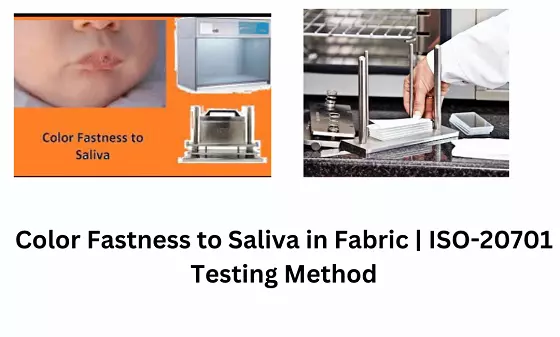In today’s blog, we will talk about the color fastness of Fabric to saliva, how to test color fastness to saliva, and which ISO method is used to test color fastness to saliva, today we will discuss all these topics, there are many types of color fastness in the textile industry. Let us talk today about the colorfastness of saliva.
Colorfastness to saliva is a measure of how well a dyed or printed textile material can resist fading or bleeding when exposed to saliva. Saliva is a fluid secreted by the salivary glands in the mouth and contains enzymes, electrolytes, and other substances.
Colorfastness to saliva is an important factor when selecting clothing or other clothing materials for infants and young children, who may frequently lick or put items in their mouths. Poor color fastness to saliva can result in color bleeding, staining, and fading, which can reduce the safety and aesthetic value of the material. Each of these tests is designed to evaluate a specific aspect of color fastness, and the results can help manufacturers ensure that their products meet desired color standards and are protected against color fading or various conditions. are resistant to transfer.

What Is Color Fastness To Saliva?
Colorfastness to saliva refers to the ability of a textile material to resist fading when exposed to human saliva. This is an important test for testing textile materials that are likely to fade or discolor when exposed to a person’s oral saliva, such as clothing, toys, and bedding.
Saliva contains enzymes and other substances that can react with dyes and pigments in textile materials, causing them to fade or migrate. The color fastness to saliva test in the textile lab involves rubbing the textile material with a solution of artificial saliva and evaluating it for any color change or staining.
Color fastness to saliva is a critical aspect of textile and dyeing industry standards. This property determines how well the color of a fabric or dye can withstand exposure to saliva, which is a common occurrence in everyday life, especially in children’s clothing and textiles. Understanding and testing color fastness to saliva is essential to ensure the durability and safety of colored textiles.
What Is the ISO Method Of Color Fastness To Saliva?
The color fastness of saliva is tested in Textile Fabric according to generally recognized industry standards, such as the ISO 20701 method. This method of testing helps ensure that textile products meet the quality and safety standards required for consumer use and that they do not cause harm or discomfort to the user.
Textile materials with good color fastness to saliva are more durable and long-lasting, retaining their appearance and color for longer periods of time even with frequent use and contact with saliva. We have come to know what is the color fastness of saliva. and what is the iso method of color fastness to saliva? Let us now know how the test of color fastness saliva is done in the lab.
Objectives Color Fastness to Saliva Test in Fabric?
- To determine the resistance of the color of textiles to saliva according to ISO 20701.
- This method uses an artificial saliva solution to detect whether the coloring material can pass from the leather to the mouth or to the mucous membrane.
Necessary Equipment for Testing:
- Perspirometer
- 11 acrylic-resin or glass plates
- Flat-bottomed dishes
- Oven, maintained at (37+2)°C
- Light box with light source D65
- Grey scale for assessing change in color (ISO 105-A02)
- Grey scale for assessing staining (ISO 105-A03)
- Multifiber adjacent fabric, type DW (ISO 105-F10)
- Chemicals for the saliva solution (see preparation of solution)
- Distilled water, grade 3
- Scale
Saliva Solution Preparation
Saliva solution, freshly prepared, containing per liter distilled water:
3.0g Lactic acid (C3H6O3)
0.2g Carbamide (CH₄N₂O)
4.5g Sodium Chloride (NaCl)
0.3g Potassium Chloride (KCI)
0.3g Sodium Sulphate (Na2SO)
0.4g Ammonium Chloride (NH4CI)
Note:- No need to bring the saliva solution to a specific pH.
Test Specimen
- Two specimens for each color and material measuring 4 cm x 10 cm.
- Details such as labels, badges, and drawstrings also need to be tested. If the product is multi-colored, make sure all colors are tested. More test specimens could be required if the product is printed, striped, or includes several colors.
- If details (including prints) are in contrasting colors these need to be tested both against the multifiber adjacent fabric and the fabric to which the detail is attached. If not in contrast color, they need to be tested only against multifiber adjacent fabric.
Method & Procedure of Color Fastness to Saliva
- 1. Cut specimens measuring 4 cm x 10cm.
- 2 Attach a specimen to multifiber adjacent fabric of the same size, by sewing along one of the shorter (4 cm) sides. The multifiber adjacent fabric should be next to the face side of the fabric.
- 3. Switch on the oven and preheat the test device (per spirometer) for 30 min.
- 4. Place the specimens in individual flat-bottomed dishes and cover them with the saliva solution at a liquor ratio of 50:1.
- 5. Thoroughly wet the specimens and allow it to remain in the solution at room temperature for 30 minutes. Press and move the specimen from time to time to ensure good and uniform penetration of the liquor.
- 6. Pour off the solution.
- 7. Place each specimen between two glass or acrylic plates and place them in the perspirometer. Each
per spirometer can hold a maximum of 10 samples. If less, all 11 plates still have to be placed in the perspirometer. Put a pressure of 12.5 kPa on the perspirometer using the load, lock it, and then remove the load. - 8. Place the perspirometer in the oven for 4 hours at (37+2)°C in the upright position.
- 9. Take out the specimens from the oven and perspirometer. Open out each specimen and dry them at room temperature, not exceeding 60’C, with the specimen only being in contact at the point of the stitching.
Result
Assess cross staining, change in color, and color staining. Compared with the Grey scale, we will get the result.
Point to be noted– To weigh the specimen and multiplying the weight by 50 is an easy way to get the correct ratio. E.g. for a specimen that weighs 2g. 100 ml solution is needed.
Conclusion
Color fastness to saliva is a significant factor in the textile industry, especially for products designed for children. Ensuring that fabrics and dyes can withstand exposure to saliva is crucial for safety, durability, and consumer satisfaction. By following standardized testing methods and taking measures to improve color fastness, textile manufacturers can produce high-quality, safe, and long-lasting colored textiles.


